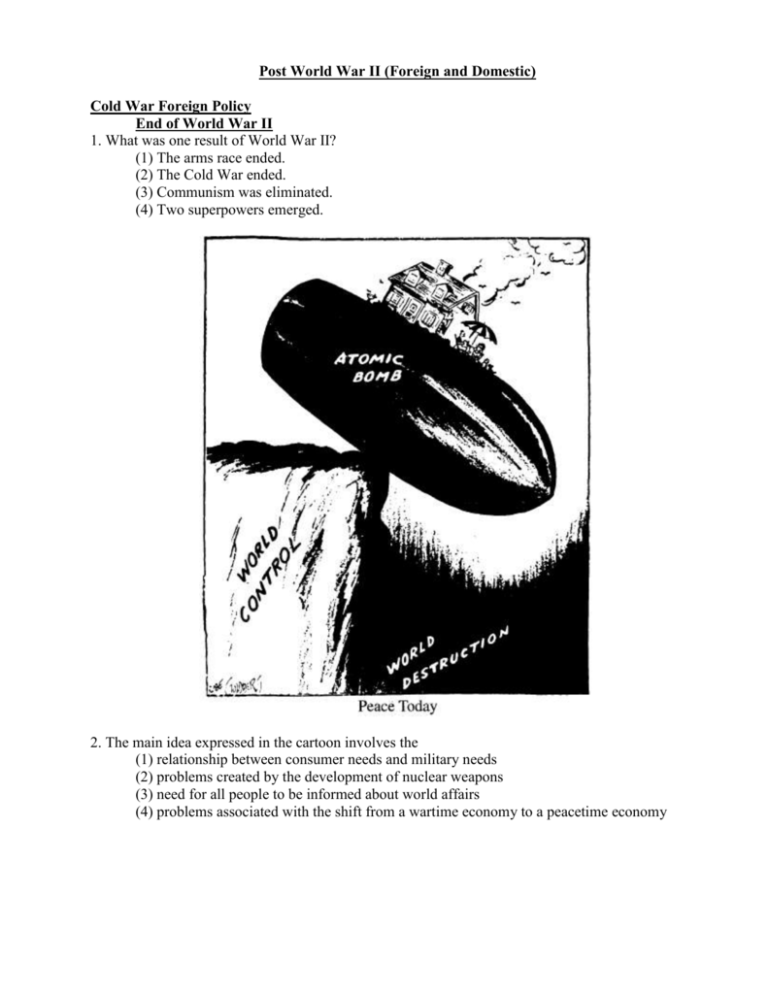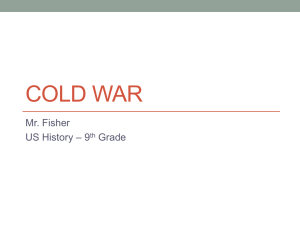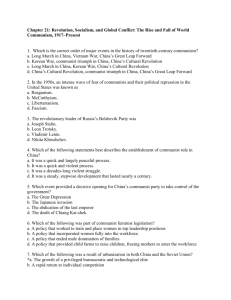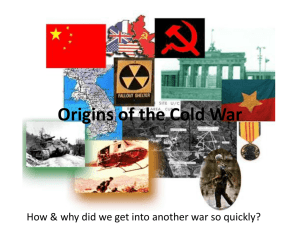Unit 10 - TeacherWeb
advertisement

Post World War II (Foreign and Domestic) Cold War Foreign Policy End of World War II 1. What was one result of World War II? (1) The arms race ended. (2) The Cold War ended. (3) Communism was eliminated. (4) Two superpowers emerged. 2. The main idea expressed in the cartoon involves the (1) relationship between consumer needs and military needs (2) problems created by the development of nuclear weapons (3) need for all people to be informed about world affairs (4) problems associated with the shift from a wartime economy to a peacetime economy 3. What is the main idea of this 1945 cartoon? (1) The world community needs to stop the spread of nuclear weapons. (2) Korea’s development of atomic bombs has threatened world peace. (3) The Treaty of Versailles was successful in preventing World War II. (4) Germany should be criticized for using atomic bombs. Base your answers to questions 4 and 5 on the speakers’ statements below and on your knowledge of social studies. Speaker A: “The use of the bomb shortened the war and saved American lives.” Speaker B: “The United States might have been able to force the Japanese to surrender simply by demonstrating the power of the bomb on a deserted island.” Speaker C: “The use of the bomb was justified because of the Japanese attack on Pearl Harbor.” Speaker D: “In Hiroshima, the bomb instantly incinerated more than 60,000 people. Most were civilians.” 4. Which speakers hold the view that using the bomb was an appropriate military action? (1) A and B (2) A and C (3) B and C (4) B and D 5. These statements most likely were made during the (1) Versailles Peace Conference (1919) (2) 1920s (3) Great Depression (4) post–World War II period 6. The war crimes trials of German and Japanese military officials following World War II established that (1) it is difficult to convict leaders of crimes against humanity (2) civil liberties must be expanded for civilians during wartime (3) individuals can be held responsible for wartime atrocities against civilians (4) genocidal acts are acceptable during wartime 7. Convictions of war criminals by courts at Tokyo and Nuremberg following World War II showed that (1) government officials and military leaders could be held accountable for their actions (2) the United Nations accepted responsibility for international peacekeeping (3) the League of Nations could successfully enforce international law (4) nations that start wars would be forced to rebuild war-torn nations 8. One reason the Nuremberg trials following World War II were held was to (1) bring Hitler, Mussolini, and Tojo to justice (2) force Japan to pay for the attack on Pearl Harbor (3) make German leaders accountable for the Holocaust (4) punish the German government for bombing England The Cold War 9. One result of the Cold War between the United States and the Soviet Union was that the two nations (1) broke all diplomatic ties (2) refused to trade with each other (3) formed competing military alliances (4) clashed over control of the Mediterranean Sea 10. During the Cold War era, the United States and the Soviet Union were hesitant to become involved in direct military conflict mainly because of (1) the threat of China to both nations (2) pressure from nonaligned nations (3) the potential for global nuclear destruction (4) mutual dependence on Middle East petroleum 11. “Soviets Create Iron Curtain in Eastern Europe” “Mao Zedong Leads Successful Revolution in China” “North Korean Invasion of South Korea Leads to War” Which development is reflected in these headlines? (1) the post–World War II expansion of communism (2) the beginning of détente between the Soviet Union and the United States (3) the return to an isolationist foreign policy (4) the beginning of pro-democracy movements during the Cold War Policy of Containment 12. Which foreign policy term would be the most appropriate title for the partial outline below? I. _________________________________ A. Truman Doctrine B. Marshall Plan C. Berlin Blockade D. Korean War (1) Imperialism (2) Appeasement (3) Noninvolvement (4) Containment 13. The primary goal of the United States foreign policy of containment was to (1) return to noninvolvement in world affairs (2) stop communist influence from spreading (3) gain territories in Africa and Latin America (4) overthrow existing dictatorships 14. In the period following World War II, the United States established a long-term military presence in West Germany in an effort to (1) support the unification of Europe, by force if necessary (2) stop communist expansion in Europe (3) prevent the renewal of German aggression in Europe (4) allow the United Nations to resolve international disputes 15. In the 1950s, the domino theory was used by President Dwight D. Eisenhower to justify (1) sending federal troops into Little Rock, Arkansas (2) United States involvement in Vietnam (3) joining the United Nations (4) opposing Britain and France in the Suez Canal crisis Truman Doctrine 16. Which foreign policy decision by President Harry Truman is an example of the policy of containment? (1) relieving General MacArthur of his Korean command (2) recognizing the new nation of Israel (3) supporting the trials of war criminals in Germany and Japan (4) providing military aid to Greece and Turkey 17. President Harry Truman supported a containment policy after World War II in an attempt to (1) limit the use of atomic bombs and other nuclear weapons (2) end colonialism in Africa and Asia (3) bring German and Japanese war criminals to justice (4) reduce the influence of the Soviet Union in European countries Base your answer to question 18 on the quotation below and on your knowledge of social studies. “It is necessary only to glance at a map to realize that the survival . . . of the Greek nation [is] of grave importance in a much wider situation. If Greece should fall under the control of an armed minority, the effect upon its neighbor, Turkey, would be immediate and serious. Confusion and disorder might well spread throughout the entire [region]. . . .” — President Harry Truman, 1947 18. The United States government responded to the situation described in this quotation by (1) reaffirming its commitment to isolationism (2) offering economic aid to many European nations (3) threatening a nuclear attack (4) supporting the efforts of the Warsaw Pact 19. In 1957, the Eisenhower Doctrine expanded the principles of the Truman Doctrine by extending Middle East military assistance in order to (1) offset communist influence in the region (2) combat anti-American terrorist threats (3) force the Organization of Petroleum Exporting Countries (OPEC) to end its oil embargo (4) defend Israel against Arab invasions 20. One similarity between the Truman Doctrine and the Eisenhower Doctrine is that both were designed to (1) limit the spread of communism (2) help develop the space program (3) restrict United States foreign aid (4) assist rebellions against the Soviet Union Base your answers to questions 21 and 22 on the speakers’ statements below and on your knowledge of social studies. Speaker A: “We have to take care of our own problems. If we get too involved in the world’s affairs, we’ll get dragged into conflicts that have nothing to do with our own security.” Speaker B: “This world is different now. Two oceans can no longer protect us. We have to take a leading role in order to stop problems before they harm our economic and security interests. We need collective security, and we have to help our allies to be economically strong.” Speaker C: “Perhaps if we had taken an active part in international peacekeeping organizations in the past, we wouldn’t have to take on the superpower role that we face now. Now we must get more involved and meet our international obligations.” Speaker D: “The arms makers and the bankers got us involved in war. The Europeans are only interested in gaining territory. Let them solve their own problems.” 21. Which speakers reflect the foreign policy beliefs of the Truman administration after World War II? (1) A and B (3) B and C (2) A and D (4) C and D 22. The statements of Speakers A and D express support for the policy of (1) containment (3) internationalism (2) imperialism (4) isolationism Marshall Plan 23. After World War II, the Marshall Plan was proposed as a way to (1) improve diplomatic relations with the Soviet Union (2) help European nations recover economically (3) remove nuclear weapons from Western Europe 4) bring Nazi war criminals to justice 24. Information provided by the graph indicates that the Marshall Plan tried to prevent the spread of communism in Europe by (1) providing military aid to France and Great Britain (2) restoring economic stability throughout Western Europe (3) encouraging domestic revolutions in Europe (4) making European nations dependent on the United Nations 25. The main foreign policy objective of the Marshall Plan (1948–1952) was to (1) stop communist aggression in Korea (2) fight poverty in Latin America (3) rebuild the economies of European nations (4) provide jobs for unemployed Americans 26. A goal of the Marshall Plan (1948) was to (1) rebuild Japan after World War II (2) provide military aid to the Warsaw Pact (3) establish a Pan-American military alliance system (4) provide economic aid to European nations threatened by communism Berlin Blockade 27. Which event of 1948–1949 is illustrated by this cartoon? (1) Berlin airlift (2) collapse of the Berlin Wall (3) reunification of Germany (4) allied invasion on Normandy 28. The United States carried out the idea expressed in this late 1940s cartoon by (1) forming a military alliance with Russia (2) airlifting supplies to West Berlin (3) accepting Russian authority over West Berlin (4) agreeing to turn over control of Berlin to the United Nations NATO 29. “The Parties to this Treaty reaffirm their faith in the purposes and principles of the Charter of the United Nations and their desire to live in peace with all peoples and all governments. “They are determined to safeguard the freedom, common heritage and civilization of their peoples, founded on the principles of democracy, individual liberty and the rule of law. . . .” — Preamble to the North Atlantic Treaty, 1949 This statement shows the commitment of the United States to the principle of (1) colonialism (2) neutrality (3) militarism (4) collective security • Announcement of Eisenhower Doctrine (1957) • Operation Desert Storm (1991) • Operation Iraqi Freedom (2003 – present) These events involve attempts by the United States to (1) protect human rights in Europe (2) protect its interests in the Middle East (3) deliver humanitarian aid to Africa (4) contain the spread of communism in Asia 31. The change in the nation’s attitude toward membership in the League of Nations and membership in the United Nations shows the contrast between (1) neutrality and containment (2) appeasement and internationalism (3) isolationism and involvement (4) interventionism and détente 30. Korean War 32. Which action occurred for the first time in the early 1950s during the Korean War? (1) United States and Soviet troops fought on the same side. (2) The United Nations used military force against an aggressor nation. (3) A president was impeached for abusing his power as commander in chief. (4) United States troops fought in Asia. 33. Which foreign policy concept influenced the decision of the United States to become militarily involved in Southeast Asia in the 1950s and 1960s? (1) appeasement (2) détente (3) peaceful coexistence (4) domino theory 34. One way in which the Korean War, the Vietnam War, and the Persian Gulf War are similar is that in all three wars (1) the goal was to defeat the Soviet Union (2) the United States was primarily interested in protecting oil supplies (3) the United States was fighting without allies (4) no formal declaration of war was made by Congress 35. What was a major outcome of the Korean War (1950–1953)? (1) Korea continued to be a divided nation. (2) North Korea became an ally of the United States. (3) South Korea became a communist nation. (4) Control of Korea was turned over to the United Nations. 36. Which generalization about the Korean War is supported by information on the maps? (1) The war began when South Korea attacked North Korea. (2) General MacArthur launched an invasion from China early in the war. (3) Neither side experienced a major military victory during the war. (4) At the end of the war, Korea remained a divided nation. 37. During the Korean War, President Harry Truman removed General Douglas MacArthur from command because MacArthur (1) called for an immediate end to the war (2) refused to serve under the United Nations (3) lacked the experience to provide wartime leadership (4) threatened the constitutional principle of civilian control of the military Cuba 38. President John F. Kennedy attempted to deal with the situation shown on the map by (1) bombing all the missile sites simultaneously (2) imposing a naval blockade to isolate Cuba from the Soviet Union (3) allowing the Soviet Union to keep some missiles in Cuba if the remainder were removed (4) landing an invasion force on the Cuban mainland 39 What was the main reason for President Kennedy’s action toward Cuba? (1) Cuba is located close to the United States. (2) The United States needed to protect business investments in Cuba. (3) The cost of building missile defense bases in Florida was high. (4) Cuba threatened to seize United States merchant ships in the Caribbean. 40. “Batista Driven from Power” “Bay of Pigs Invasion Fails” “U-2 Planes Reveal Soviet Missiles” These headlines refer to the relationship between the United States and (1) Canada (2) Cuba (3) Mexico (4) Panama 41. “U.S. Sponsors Panamanian Revolution” (1903) “U.S. Establishes Military Rule in Dominican Republic” (1916) “CIA Supports Overthrow of Guatemala Regime” (1954) These headlines suggest that (1) United States interests in Latin America have often led to intervention (2) the United States is willing to fight to maintain the independence of Latin American nations (3) Latin American nations have declared war on the United States several times (4) Latin American nations are able to run their governments without United States help 42. What was a result of the takeover of Cuba by Fidel Castro? (1) Relations between the Soviet Union and Cuba worsened. (2) Many Cuban Americans returned to their homeland. (3) Trade between the United States and Cuba increased. (4) Many people fled from Cuba to the United States. Answers for Cold War Foreign Policy 1) 4 2) 2 3) 1 4) 2 5) 4 6) 3 7) 1 8) 3 9) 3 10) 3 11) 1 12) 4 13) 2 14) 2 15) 2 16) 4 17) 4 18) 2 19) 1 20) 1 21) 3 22) 4 23) 2 24) 2 25) 3 26) 4 27) 1 28) 2 29) 2 30) 2 31) 1 32) 2 33) 2 34) 4 35) 1 36) 4 37) 2 38) 2 39) 1 40) 2 41) 1 42) 4 Cold War Domestic Policy Fear of Communism (McCarthyism, HUAC, Rosenbergs, & Bomb Shelters) 1. The growth of McCarthyism in the early 1950s was based on (1) public fear concerning the spread of communism (2) outrage over government corruption (3) dissatisfaction with the results of World War II (4) opposition to the policy of containment 2. One way in which the Red Scare of the 1920s and McCarthyism of the 1950s were similar is that both (1) jeopardized the rights of individuals suspected of un-American activity (2) occurred during times of economic depression (3) addressed the issue of increased government bureaucracy after a world war (4) led to the imprisonment of ethnic minorities during wartime 3. What was a cause for the investigations of the House Un-American Activities Committee in the late 1940s and the investigations of a Senate committee headed by Joseph McCarthy in the early 1950s? (1) the belief that there were Communist agents in the federal government (2) excessive spending by the United States military (3) the corruption and bribery of members of Congress (4) actions of President Harry Truman that might have led to his impeachment 4. In the post–World War II era, Senator Joseph McCarthy and the House Un-American Activities Committee attempted to (1) develop an effective system for spying on other countries (2) make Cold War programs a priority in United States foreign policy (3) identify Communists in the government and elsewhere in American society (4) establish a policy of détente with the Soviet Union 5. Who led a “witch hunt” for Communist spies in the United States government during the early 1950s? (1) Supreme Court Justice Earl Warren (2) President Dwight Eisenhower (3) Senator Joseph McCarthy (4) Secretary of State Dean Acheson 6. The Palmer raids following World War I and the McCarthy hearings during the Korean War were similar in that they were caused by fear of (1) new military weapons (2) foreign invasions of the United States (3) communist influence in the United States (4) economic depression 7. Since the 1950s, the term McCarthyism has been applied to events that are related to (1) the basic rights of citizens to own and carry guns (2) the violent activities of international terrorists (3) reckless accusations unsupported by evidence (4) questionable methods used to finance political campaigns 8. “. . . The American people are sick and tired of being afraid to speak their minds lest they be politically smeared as ‘Communists’ or ‘Fascists’ by their opponents. Freedom of speech is not what it used to be in America. It has been so abused by some that it is not exercised by others. The American people are sick and tired of seeing innocent people smeared and guilty people whitewashed. But there have been enough proved cases to cause nationwide distrust and strong suspicion that there may be something to the unproved, sensational accusations...” — Senator Margaret Chase Smith, United States Senate, June 1, 1950 When Senator Smith spoke these words, she was reacting to (1) the Yellow Peril (2) McCarthyism (3) the Eisenhower Doctrine (4) Progressivism 9. During the early 1950s, the tactics of Senator Joseph McCarthy were criticized because he (1) violated important constitutional liberties (2) displayed racial prejudice in his questions (3) opposed the use of loyalty oaths (4) ignored evidence of Soviet spying 10. McCarthyism in the early 1950s resulted from (1) new commitments to civil rights for African Americans (2) opposition to the Marshall Plan (3) charges that Communists had infiltrated the United States government (4) increased public support for labor unions 11. The protestors in the photograph are expressing their hatred for (1) fascists (2) communists (3) immigrants (4) police officers 12. The trial of Sacco and Vanzetti in the 1920s was similar to the trial of the Rosenbergs in the 1950s in that both trials were accompanied by (1) nativist fears of foreign influence in the United States (2) concern that the United States would sink into a depression (3) public reactions against organized crime (4) a grassroots movement to gain equal rights for minorities 13. What does this photograph indicate about the United States in the 1950s? (1) Extraordinary steps were taken to hide atomic weapons. (2) The nation had become the only nuclear superpower. (3) Much fear was created by the Cold War. (4) Only government officials would be safe in a nuclear attack. 14. Which heading is most appropriate for the partial outline below? I.____________________________________ A. The House Un-American Activities Committee B. Loyalty review boards C. Bomb shelters D. Watkins v. United States (1957) (1) Results of World War I (2) The Cold War at Home (3) Problems of Urbanization (4) Reactions to Immigration Reaction to Sputnik 15. “Sputnik Launch Propels Soviets Ahead in Space Race” In 1957, the United States government responded to the event described in this headline by (1) reducing military spending (2) building a joint space station with the Soviet Union (3) constructing President Ronald Reagan’s “Star Wars” defense system (4) providing funds to improve the educational system in the United States 16. The immediate impact of the 1957 launch of Sputnik I was that it (1) forced the United States to find new sources of fuel (2) focused attention on the need to regulate the uses of outer space (3) heightened the space race as a form of Cold War competition (4) ended the period of peaceful coexistence between the United States and the Soviet Union 17. Which event of the 1950s most likely led to the publication of this cartoon? (1) Russia put cosmonauts on the Moon. (2) The Soviet Union launched the Sputnik satellite. (3) The United States was defeated in the Vietnam War. (4) American students scored low on tests in math and science. 18. “ . . We choose to go to the moon. We choose to go to the moon in this decade and do the other things, not because they are easy, but because they are hard, because that goal will serve to organize and measure the best of our energies and skills, because that challenge is one that we are willing to accept, one we are unwilling to postpone, and one which we intend to win, and the others, too. . . .” — President John F. Kennedy, speech at Rice University, September 12, 1962 The main purpose of this speech was to win public support for (1) establishing a missile defense system on the Moon (2) cooperating with communist countries in exploring space (3) surpassing the Soviet Union in the space race (4) controlling the spread of nuclear weapons Demographic and Economic Changes 19. Which development following World War II caused the urban-suburban pattern shown in the diagram? (1) increase in the number of farms (2) expansion of highways and automobile ownership (3) movement of most factories to rural areas (4) decline in the number of middle-income families 20. How did the post–World War II baby boom affect American society between 1945 and 1960? (1) It decreased the demand for housing. (2) It bankrupted the Social Security System. (3) It increased the need for educational resources. (4) It encouraged people to migrate to the Sun Belt. 21. The rapid growth in personal income in the decade after World War II contributed to (1) a decrease in the birthrate (2) a major economic depression (3) expansion of the middle class (4) shortages in the supply of luxury goods 22. Which situation is associated with the trends in agriculture shown in these tables? (1) Farm foreclosures decreased. (2) Farm size was substantially reduced. (3) Farm output declined. (4) Farmers became a smaller percentage of the labor force. 23. This photograph shows the post–World War II growth that was typical of (1) tourist resorts (2) suburban communities (3) inner cities (4) public housing projects 24. The changes shown on the chart most clearly reflect the (1) effects of the Cold War (2) influence of the business cycle (3) failure of United States military policy (4) reverses in political party control of Congress Answers For Cold War Domestic Policy 1) 1 2) 1 3) 1 4) 3 5) 3 6) 3 7) 3 8) 2 9) 1 10) 3 11) 2 12) 1 13) 3 14) 2 15) 4 16) 3 17) 2 18) 3 19) 2 20) 3 21) 3 22) 4 23) 2 24) 1









